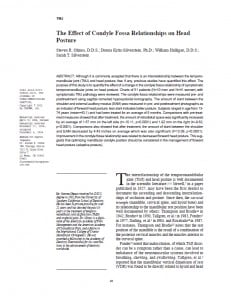THE JOURNAL OF CRANIOMANDIBULAR PRACTICE | January 2005
Steven R. Olmos, D.D.S.; Donna Kritz-Silverstein, Ph.D.; William Halligan, D.D.S.; Sarah T. Silverstein
Although it is commonly accepted that there is an interrelationship between the temporomandibular joint (TMJ) and head posture, few, if any, previous studies have quantified this effect. The purpose of this study is to quantify the effect of a change in the condyle fossa relationship of symptomatic temporomandibular joints on head posture. Charts of 51 patients (N=10 men and N=41 women) with symptomatic TMJ pathology were reviewed. The condyle fossa relationships were measured pre- and posttreatment using sagittal corrected hypocycloidal tomography. The amount of slant between the shoulder and external auditory meatus (EAM) was measured in pre- and posttreatment photographs as an indicator of forward head posture; less slant indicates better posture. Subjects ranged in age from 13-74 years (mean=43.1) and had been treated for an average of 5 months. Comparisons with pre-treatment measures showed that after treatment, the amount of retrodiskal space was significantly increased by an average of 1.67 mm on the left side (t=-10.11, p<0.0001) and 1.92 mm on the right (t=-9.62, p<0.0001). Comparisons also showed that after treatment, the amount of slant between the shoulder and EAM decreased by 4.43 inches on average which was also significant (t=13.08, p<0.0001). Improvement in the condyle fossa relationship was related to decreased forward head posture. This suggests that optimizing mandibular condyle position should be considered in the management of forward head posture (adaptive posture).


